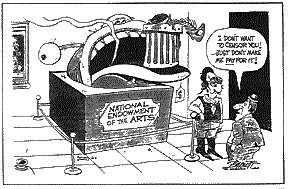Spiritual Crisis in the Arts
Do the Arts shape society or only reflect it?

Just as beautiful art can inspire and ennoble, degrading art can depress and demean. The degradation of art in America has reached epidemic proportions.
Regardless of the form of artistic expression whether it be painting, sculpture, dance, drama, music, writing, photography, or motion pictures the emphasis has shifted from the portrayal of beauty to the exhibition of the bizarre, the blasphemous, and the obscene. There seems to be a rush within the artistic community to find the lowest common denominator and then to lower it even further.
Instead of artists like Michelangelo and Beethoven who dedicated their talents to the glory of God, we are plagued with artists like Andy Warhol, Martin Scorsese, Gore Vidal, and Madonna “artists” who traffic in the lewd, the sensational, and the profane.
Even non-Christian spokesmen like Steve Allen have become appalled. In a recent speech, he observed: “We live in a very sick society in which rudeness, sadism and sex have all become commodities.” He pointed out that artists seem to go out of their way to be objectionable. Referring to his own field of artistic expression, he said, “American humor has never been as filthy as it is now.” He concluded his remarks by saying, “We have become a society of barbarians who love to be entertained by vulgarians.”
The Root of the Problem
Is art the cause or the effect? Does it promote the disintegration of society, or is it merely a reflection of what is happening? Actually, it is both. The artist certainly reflects the heart of his culture, but in the process, his expression of that heart can either raise or lower the standards of his society.
Take the current television program, “NYPD Blue,” for example. The coarse language, gratuitous violence, and explicit sex which it has introduced to our nation’s television screens is surely a reflection of the sordid condition of our society. But in the process of introducing these elements to television under the guise of “freedom of artistic expression,” the program has lowered the standards of television and has opened the floodgates for a spate of copy-cat programs, each of which will try to out-gross its competitor. In the process, our culture will be further demeaned by a greater dosage of immorality and violence on the home television screen.
I don’t think there is any way around the conclusion that art is as much a part of the problem in our society today as it is a reflection of our problems.
Our society is in the grip of a spiritual crisis. Art reflects that crisis, but it also contributes to it. Art has become a tool of propaganda in the hands of anarchists who are determined to destroy the Judaic-Christian foundations of Western civilization.
Government Involvement
Since 1965 our government has contributed to the assault of art upon our godly heritage. In that year the Congress established the National Endowment for the Arts, and that organization, from its inception, has dedicated itself to the propagation of the perverse. We are now faced with the incredible scenario whereby our government takes our tax money and gives it to artists who use it to attack the very values that we hold dear! And when we object, we are accused of being censorship bigots who do not believe in freedom of speech!
To give us a better perspective on the whole situation, I have invited a world-class artist, John Pototschnik, to share his insights about the matter.
The Foundations of Cultural Death
John Pototschnik
I recently received a letter from a young lady who is an art major at West Virginia University in Morgantown. She has become very disheartened by the way art is being taught. In her words, “It seems to be that the instructors feel nothing has any value unless it’s this great abstract work that is loaded with hidden meaning which the viewer could never even hope to uncover.”
Her greatest desire has always been to do portraits, and from the time she was a little girl, she always wanted a career in art. Now, at West Virginia, she’s questioning whether that will ever happen. Her latest classroom assignment is a three by six foot drawing of a tattooed corpse. “It seems that the more bizarre and stranger something is, the greater they like it,” she said.
This story is being repeated by the thousands across this land. With only a few exceptions, the traditional art school training of a hundred years ago has completely disappeared. We don’t know how many potentially great artists have been aborted by sucking the creative life out of them through liberal, directionless instruction.
Probing Questions and a Chilling Reality
How did we get in this fix anyway? Why is it so difficult to find solid training in art today? Why is it virtually impossible for contemporary traditional, realist artists to get their work hung in any American museum?
How does a nation get to the point of not only supporting but actually funding projects that result in such deplorable exhibitions as a crucifix submerged in urine? How has it come to pass that a pile of sand dumped in the corner of a museum is called art, or the drips and splatters of a frustrated classical artist now have deep meaning? Why is it that “performance artists” Tim Miller and Karen Finley, who perform in the nude, are the type of people the National Endowment for the Arts (NEA) desires to give taxpayer money to?
When the American people, especially Christians, heard of the NEA funding for Robert Mapplethorpe and Andres Serrano, there was an uproar. Mapplethorpe, who recently died of AIDS, received $30,000 to put together an exhibit that contained some photographic images that were so repulsive and degrading that Senator Jesse Helms felt he could not even speak of them on the Senate floor. (One photo showed a person urinating into the mouth of another person!) Serrano was the one who received a $15,000 grant which helped fund his famous photo of the crucifix in the urine. Examples like these go on and on.
The point is that our government, expressed through its agency, the NEA, has departed from the God of our forefathers. No longer are we separating ourselves from this God through neglect. The reality is that there is now a conscious and deliberate effort to distance our society from God.

The Roots of the Rebellion
I am restricted by space from elaborating fully on the evolution of philosophical thinking that has brought us to this point, but a few things can be said.
Traditional values and morals, along with any basic hope for the future, were really shattered by World War I. That event was so cataclysmic that it destroyed the faith that had been building throughout the 19th century in the inevitability of progress. After World War I it was no longer taken for granted that Western Civilization would survive, and many questioned whether a reliance on traditional values would enable it to do so. From the modernist’s perspective, one of the most basic assumptions of Western civilization was no longer credible that is, that man could discern and solve every problem and thus control his world through reason.
This thinking was further influenced strongly by Sigmund Freud’s studies of the unconscious. He declared that it was really the unconscious and not reason that was master of human behavior.
Another manifestation of modernism was “primitivism” as taught by Jean Rousseau. He proposed that primitive man, “the noble savage,” was superior to civilized man. “If man is good by nature, it follows that he stays like that as long as nothing foreign to him corrupts him.” It was this kind of thinking that prompted an artist like Paul Gauguin to desert his family and go to Tahiti in search of purity and freedom.
Rousseau also argued that the best education is no education. This had a dramatic impact on later education theories of unbridled self-expression which continue to this day.
Based on discoveries of the unconscious, the primitive, and the irrational in human nature, the modernists concluded it was absurd to put any faith in human reason.
The Revolt against Reason in Art
Deprived of a Christian view of the cosmos as orderly and purposeful, the modernists came to see it as fragmented, chaotic and without transcendent meaning. If the cosmos is fractured and fragmented, if life is chaotic and meaningless, if the self is only an assemblage of irrational and uncontrollable impulses, then art must reflect this broken and disharmonious reality.
Traditionally it was the artist’s role to take all the bits and pieces of life and assemble them into a unified and intelligible form that would please and inspire. The modernists rejected this role and sought to create an art that would embody and communicate their disturbing perception of reality as fractured and chaotic. Hence Picasso, Braque, Gris, and Duchamp.
The inward looking art of the modernists led to an art that was so highly personal that it became virtually incomprehensible. Modernists’ art became a very private affair, open only to a limited few, the initiated.
What really mattered was not what the public saw, but what the artist felt. If you claimed to understand this stuff, you immediately set yourself above the dumb, ignorant masses. You now became one of the intelligentsia, an elite group. Hence, a whole army of art critics sprang up spouting gobbledegook.
Modernism was characterized by skepticism and radical questioning of the value of society, of morality, of reason, of religion, even of life itself. After all, if God does not exist, all things are permitted. Without God there is no foundation on which one can base values or beliefs thus anything goes and nothing matters.
In the post-modern world of today this attitude predominates. The highly structured and thorough training once found in the art academies is now a thing of the past. Today, instead of sound training in drawing, composition and anatomy, the student is encouraged to get in touch with the inner self and express that. The expression of one’s feelings is all that matters.
But this is ridiculous. Expecting a person with no solid training in art to produce a work of art is like asking a person to become an author before learning a language. How many of us would spend money to go to a piano recital knowing that the soloist knows nothing of music or the piano? It’s an absurd thought, and yet we will let the powers that be get away with this insanity.
The Constitutional Struggle
The modernist obsession with expressionism has produced a constitutional battle in America over the meaning of the First Amendment’s guarantee of “freedom of speech.” The modernists claim that this guarantee protects all forms of artistic expression. But isn’t there a difference between speech and expression?
The Constitution guarantees freedom of speech, not freedom of expression. Speech involves words. Expression can involve words too, but it encompasses much more, like the burning of a flag.
Since the Supreme Court’s interpretation of the First Amendment has come to embrace the concept of freedom of expression, the door has been opened to unlimited self-expression, which will eventually produce chaos. Therefore, I believe the First Amendment battle has less to do with self-expression than it does with destruction.
The NEA, through its encouragement of the base, the shocking and the worthless, contributes to the destruction of our heritage, the destruction of Judeo-Christian roots, and the destruction of our freedoms. People cannot and will not tolerate a chaotic society. We will gradually give up more and more of our freedoms, resulting in more laws and< more government control, for the sake of peace and order.
The Need for Parameters
I think most people reading this article would agree that America has Judeo-Christian roots. The Constitution and the Bill of Rights were written and interpreted under that covering. Since those roots are presently being ripped up, I am not for freedom of expression as currently defined. Nor do I favor public funding of the arts through the NEA, for it is an elitist government agency that encourages the creation of expressionistic garbage that would never see the light of day in the marketplace.
Our former Judeo-Christian foundation provided a solid base upon which creative freedom existed within guidelines, and I would say America produced some pretty great art upon that foundation. Consider Stuart, Homer, Cole, Sargent, and Inness.
Dutch painting of the 17th century, built also upon this same base, is rightly called the Golden Age and was one of the most intensely creative periods of artistic activity the world has ever known. Rembrandt, Vermeer, Hals, Ruisdael, and Jan Steen are products of this environment.
Now the cry of the modernists is, “There can be no art if there is regulation.” In contrast, Aleksandr Solzhenitsyn has said, “Creative freedom without guidelines can be dangerous, for the fewer artistic limitations that he [the artist] imposes on his work, the less chance he has for artistic success. The loss of a responsible organizing force weakens or even ruins the structure, the meaning, and the ultimate value of a work of art.”
Think of it this way: Would you buy an automobile that was built without guidelines? I think not. Is an auto any less creatively designed because its designer had to abide by guidelines?
I believe our guide for how to express ourselves creatively is found in the Creator of the universe. His creation is beautiful, it is organized, it has purpose and meaning. It expresses diversity within unity, and it reveals His wisdom and character.
The Anarchy of Free Expression
In closing, I want to emphasize that anarchy will result from absolute freedom of expression. That’s what is being called for.
We need to keep in mind that there is such a thing as absolute truth, and that truth has< been revealed in God's Word in the form of absolute moral guidelines. These aren't the moral guidelines established by special interest groups but rather the loving counsel of a Father who cares about His creation and knows what is best for it.
Please tell me what’s wrong with moral conviction? What happened to “love the Lord your God with all your heart, soul and mind and your neighbor as yourself”? How many of us would like a picture of ourselves or our loved ones displayed in a jar of urine? To me, that indicates scorn, mockery, disdain and ridicule. Where is the love in that?
Is freedom of expression a higher law than loving one another?
This nation has become like a little undisciplined, rebellious child. We can’t be comfortable within wise and respectable guidelines. The boundaries must always be pushed. “Self” becomes all important. The cry is that “no one has a right to tell me what to do or to limit my self-expression.”
Wisdom is shouting in the streets. Look where unbridled freedom of expression and lax justice has brought us: violent crime the highest rate in the world; divorce highest in the world; abortion the highest in the world; pornography more produced in and exported from America than anywhere else. Robbery, rape, drug abuse, child abuse, AIDS, greed, disrespect of authority and filth of every kind abounds in our society of unbridled freedom.
I believe all this is a result of our godless society saying, “Where is this so-called God any way? I shall make my own decisions. I know what’s best for me. No one has a right to restrain me.” The result is anarchy in the arts and the streets.
With regard to the arts, Patrick Buchanan has summed it up well:
“Many museums now feature exhibits that can best be described as cultural trash. As in public television and public radio, a tiny clique, out of touch with America’s traditional values, has wormed its way into control of the arts bureaucracy. As with our rivers and lakes, we need to clean up our culture; for it is a well from which we must all drink. Just as a poisoned land will yield up poisonous fruits, so a polluted culture, left to fester and stink, can destroy a nation’s soul.”
Our only hope is to turn our hearts back to our Creator God, yielding ourselves to the loving restraints He has given us in His moral law. When we do that, the arts will once again become an expression of the highest ideals of the human soul.
John Pototschnik, his wife, Marcia, and their two sons live in Wylie, Texas, a suburb of Dallas. John was born in England but grew up in Kansas and received a BFA degree from Wichita State University. After a stint in the Air Force, he went to Los Angeles where he attended the Art Center College to prepare himself for a career as a professional illustrator. For ten years he worked as a free-lance illustrator before he decided in 1981 to devote his talents to fine art painting in oils. John calls his painting style “naturalism.” He is a very accomplished landscape painter. But John still uses his illustration skills to paint pictures that communicate a story. John has won many contests and awards, including several Freedom Foundation medals for a series of paintings celebrating America’s Independence Day.




